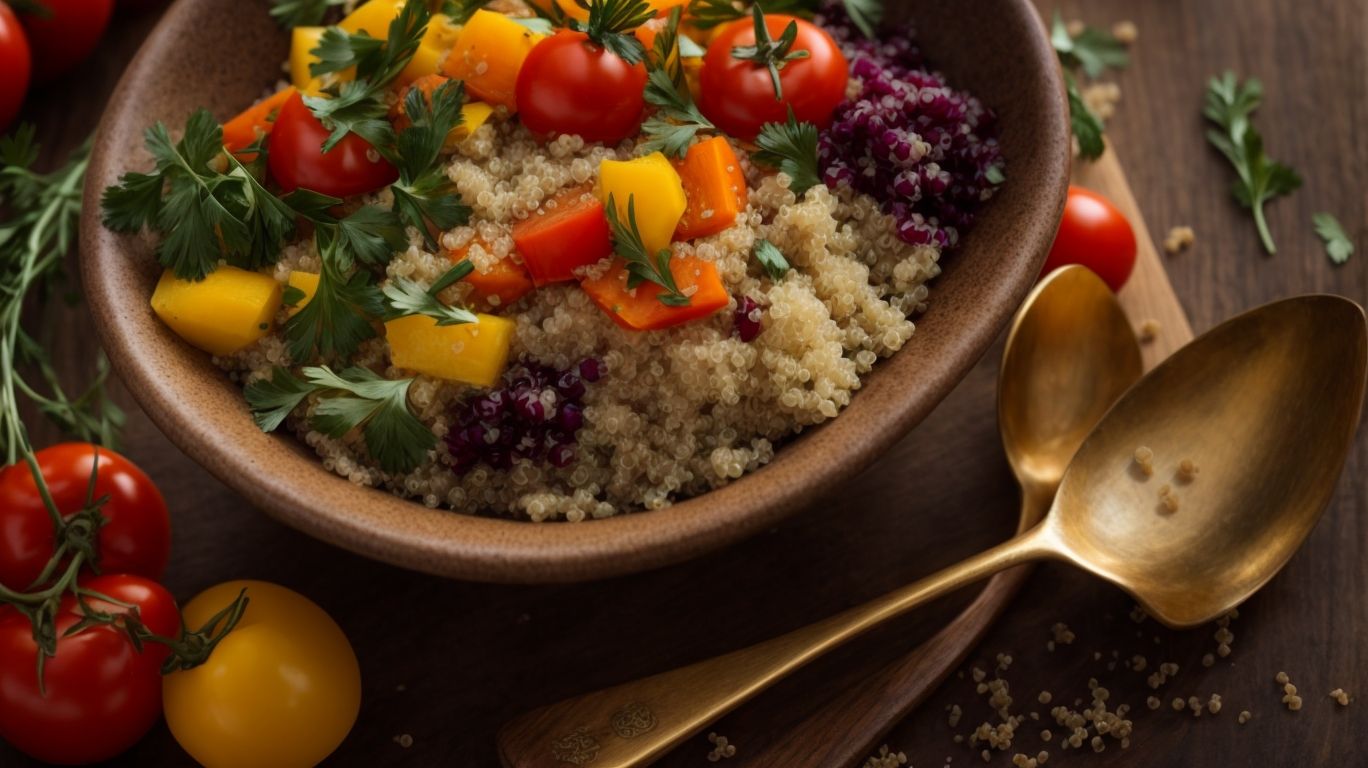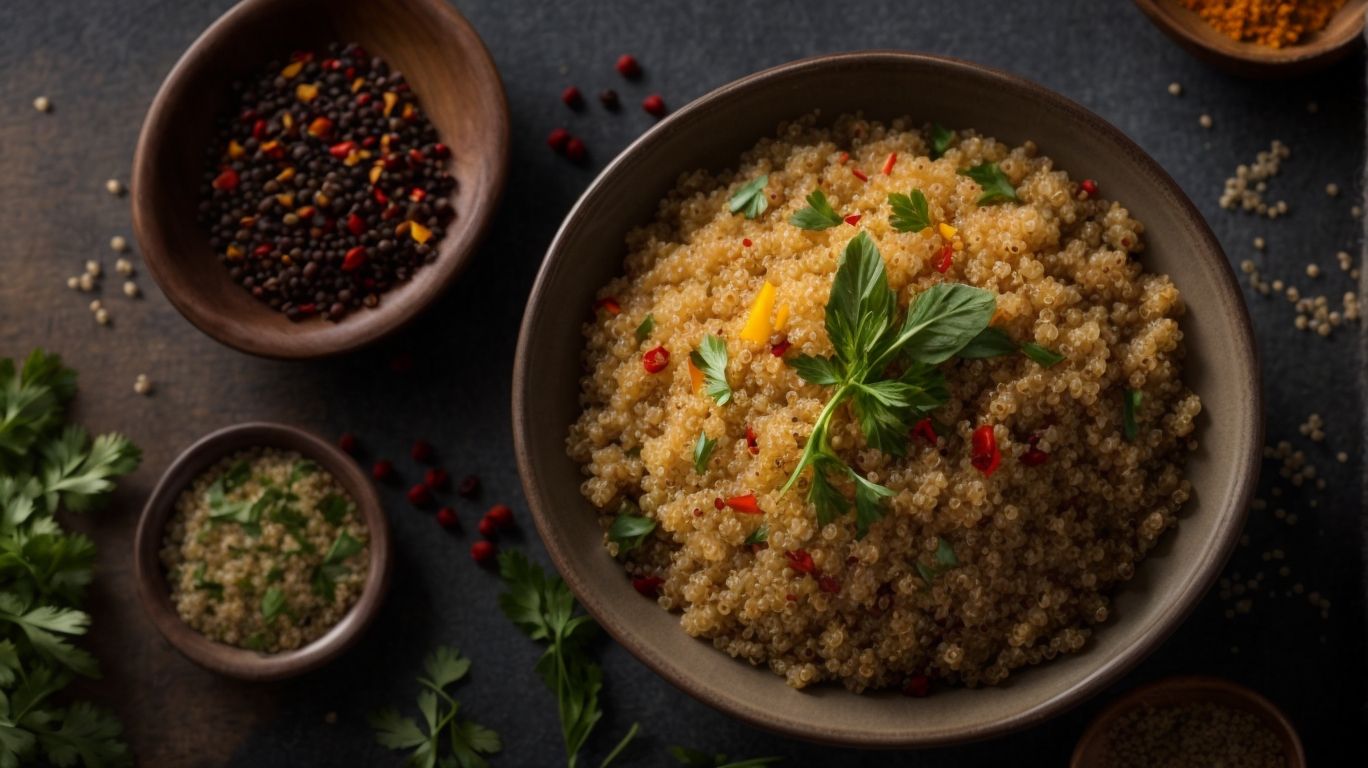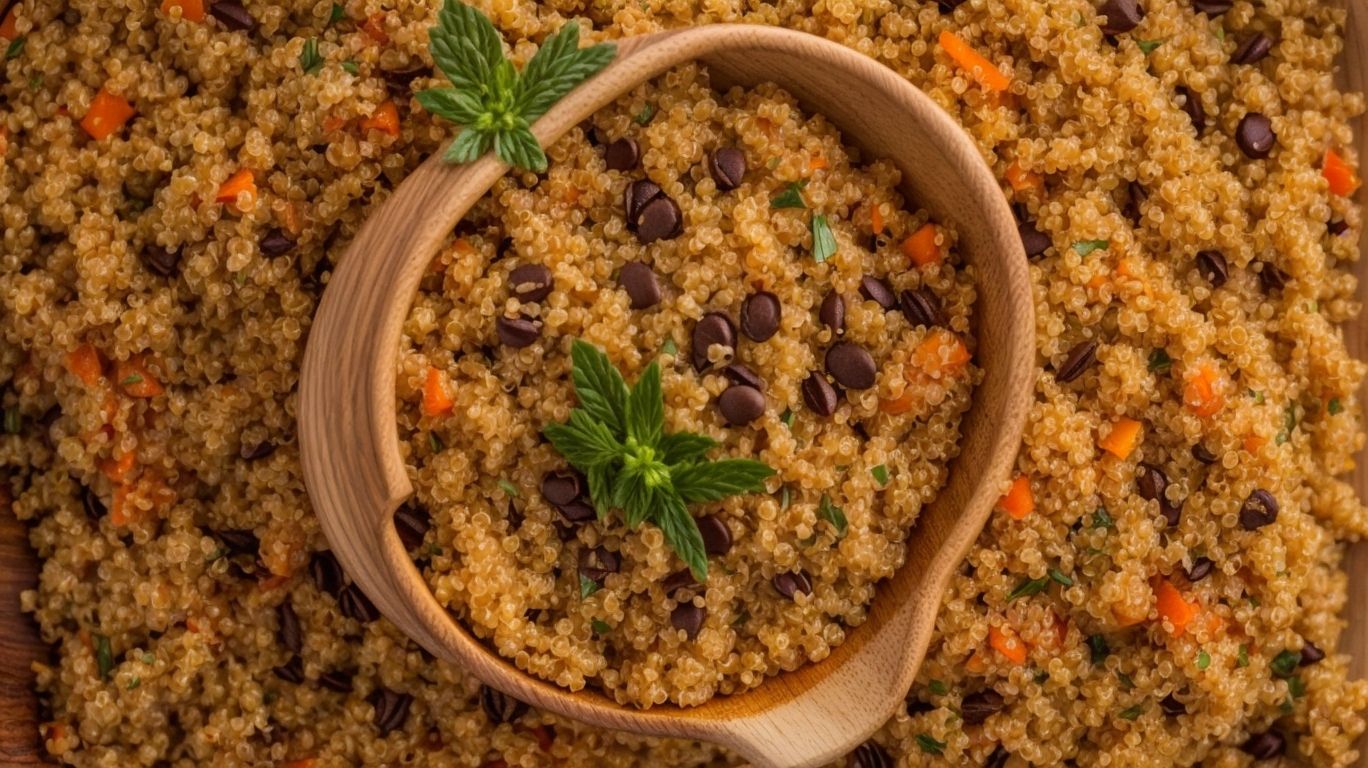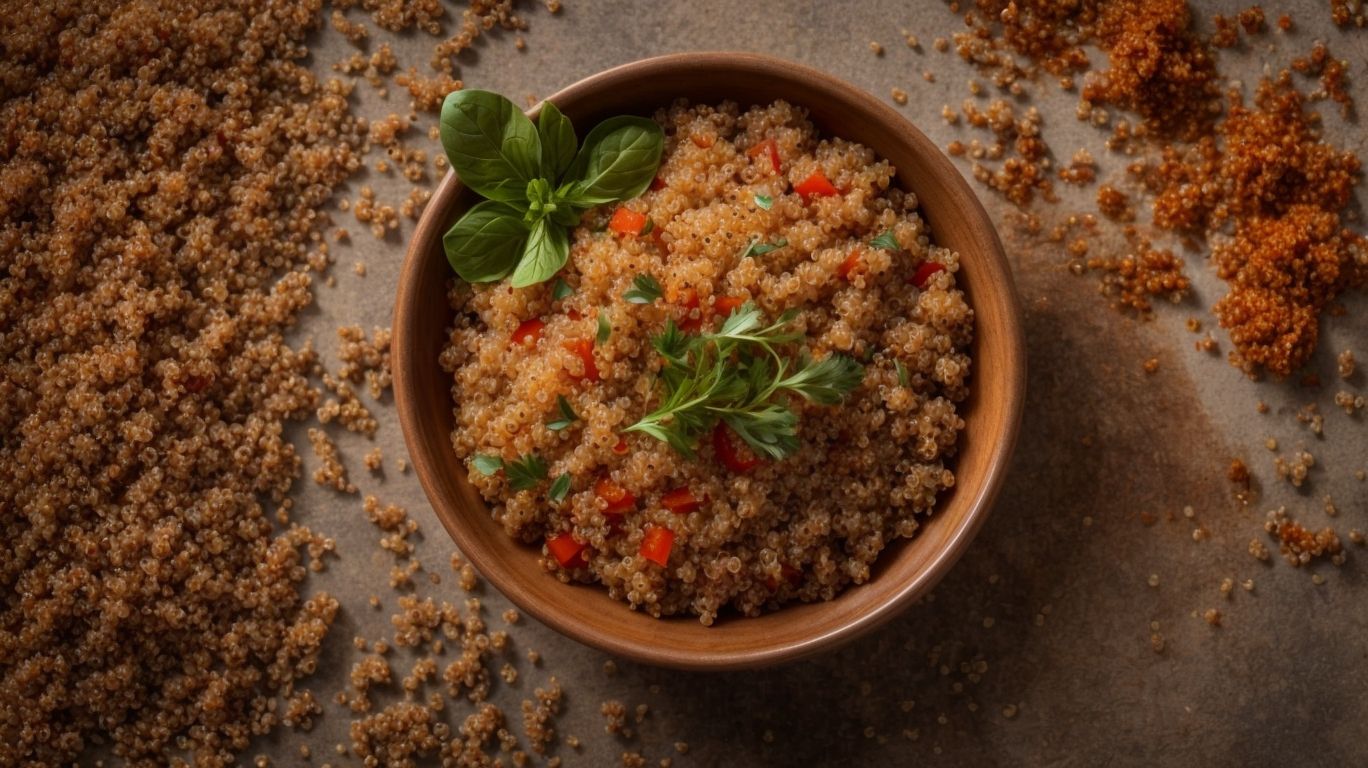How to Cook Quinoa Without Bitter Taste?
Quinoa, a versatile and nutritious grain, has gained popularity in recent years for its health benefits and delicious taste.
We explore the different types of quinoa, its nutritional benefits, and how to cook it perfectly without the bitter taste that some people experience.
Learn about rinsing and toasting the quinoa, using broth instead of water, and other tips and tricks to make your quinoa dishes flavorful and enjoyable.
Stay tuned for some mouth-watering quinoa recipes that will elevate your cooking game!
Key Takeaways:
What Is Quinoa?
Quinoa, a pseudocereal, is a flowering plant in the amaranth family known for its edible seeds.
Originally cultivated by the Incas in the Andean region of South America, quinoa has a rich history dating back thousands of years. It was considered a sacred crop by the ancient civilizations, prized for its nutritional value and versatility. Despite being commonly referred to as a grain due to its similar culinary uses, quinoa is botanically classified as a seed, making it a pseudo-cereal. The small seeds of quinoa are loaded with essential nutrients like protein, fiber, and various vitamins and minerals, making it a popular choice for health-conscious individuals looking to diversify their diet.
What Are the Different Types of Quinoa?
Various types of quinoa exist, including white, red, and black quinoa, each offering unique flavors and textures.
White quinoa is the most common variety, known for its mild, nutty flavor and fluffy texture once cooked. Red quinoa, on the other hand, has a slightly earthier taste and holds its shape well, making it ideal for salads and pilafs. Black quinoa, with its striking color and slightly sweeter profile, adds visual appeal and depth of flavor to dishes.
White quinoa is versatile and pairs well with various ingredients, while red quinoa’s firmer texture makes it suitable for stuffing vegetables or adding to soups. Black quinoa’s unique appearance makes it great for garnishing dishes or creating visually appealing salads.
What Are the Nutritional Benefits of Quinoa?
Quinoa is a nutritional powerhouse, rich in protein, fiber, and essential nutrients, with a texture akin to starchier pasta.
Protein is an essential macronutrient crucial for muscle repair and growth, and quinoa is a great plant-based source of this vital nutrient.
The high dietary fiber content in quinoa aids digestion, promotes a feeling of fullness, and helps regulate blood sugar levels.
The unique texture of quinoa allows it to be a versatile ingredient, making it suitable for various culinary uses, from salads to main dishes.
How to Cook Quinoa?

Credits: Poormet.Com – Walter Flores
Cooking quinoa is a simple process that involves rinsing, toasting, and simmering the grains to enhance their flavor and texture.
To begin, start by rinsing the quinoa under cold water in a fine-mesh strainer to remove the bitter outer coating called saponin.
Then, toast the quinoa in a dry skillet for a few minutes to deepen its nutty flavor.
Next, add the rinsed and toasted quinoa to a pot with water or broth, using a 2:1 ratio.
Bring it to a boil, then reduce the heat, cover, and simmer for about 15 minutes until the quinoa is light and fluffy.
Fluff it with a fork and let it sit covered for a few more minutes before serving to ensure perfect texture and flavor.
Rinse the Quinoa
Rinsing quinoa is essential to remove the bitter saponin coating and prevent a bitter taste in the cooked grains.
When you rinse quinoa, you are essentially washing away any residue of saponins, the natural compounds that can impart a harsh flavor to the cooked grains. This quick and simple step makes a world of difference in the taste and texture of your quinoa dishes. By rinsing it under cold running water, you ensure a clean slate for the quinoa to absorb flavors during cooking, resulting in a more balanced and pleasant culinary experience.
Toast the Quinoa
Toasting quinoa before cooking enhances its nutty flavor and adds depth to the dish.
Toasting quinoa is a simple yet effective technique that can truly transform the taste and texture of this nutritious grain. When you toast quinoa, you are essentially unlocking a whole new world of flavors, releasing its natural nuttiness and enhancing its overall profile. By applying heat to the quinoa seeds in a dry pan, you are able to intensify the depth of flavor, resulting in a richer and more aromatic end product. This process also helps to develop a slightly crunchy texture, adding dimension to your dishes. Make sure to keep a close eye on the quinoa as it toasts to prevent burning and achieve the perfect toasty aroma.
Add Liquid and Bring to a Boil
Adding liquid to quinoa and bringing it to a boil is the next step in the cooking process, allowing the grains to absorb flavor and moisture.
Properly measuring the water is crucial at this stage to ensure that the quinoa cooks evenly and to the right consistency. Remember, quinoa has the superpower of soaking up the water like a sponge, so you don’t want to drown it but aim for just the perfect amount. A general rule of thumb is usually a 1:2 ratio of quinoa to water, but this can vary depending on the recipe. Once you’ve poured in the water, give it a gentle stir and then let it work its magic as it simmers and transforms into a fluffy, nutty grain.
Reduce Heat and Simmer
Reducing the heat and simmering quinoa gently allows it to cook through while preserving its delicate flavor and texture.
During the simmering stage of cooking, it’s important to keep an eye on the quinoa to prevent it from becoming too mushy or overcooked. Maintaining a gentle simmer ensures that the quinoa absorbs the liquid evenly and cooks to perfection.
Simmering also helps to enhance the flavor of the quinoa as it slowly releases its nutty aroma into the surrounding liquid. The gentle heat allows the natural oils in the quinoa to develop, resulting in a richer taste profile.
Fluff and Let It Rest
Fluffing the cooked quinoa with a fork and letting it rest for a few minutes helps to achieve a light and fluffy texture with enhanced flavor.
Once the quinoa is fully cooked and the liquid has been absorbed, it’s time to start the fluffing process. Grab a fork and gently run it through the quinoa, separating the grains and allowing any excess moisture to evaporate. This not only helps to prevent clumping but also aerates the quinoa, making it light and airy.
After fluffing, resting the quinoa for about 5-10 minutes is crucial. This step allows the quinoa to finish steaming off the heat and lets the flavors meld together, resulting in a more harmonious taste profile. During this resting period, you can cover the quinoa with a lid or a clean kitchen towel to retain heat and moisture.
Why Does Quinoa Taste Bitter?

Credits: Poormet.Com – Stephen Adams
The bitterness in quinoa is due to saponins, a natural compound that serves as an evolutionary defense mechanism for the plant against predators.
Saponins are a type of plant chemical that are found in a variety of plants, including quinoa. These compounds have a bitter taste and are often used by plants as a defense mechanism to deter animals from consuming them. When quinoa is not rinsed properly before cooking, the saponins can remain on the outer layer of the grain, resulting in a bitter taste in the final dish.
Despite the bitterness caused by saponins, they also offer some health benefits, such as antioxidant and anti-inflammatory properties. Their presence can significantly impact the culinary experience of consuming quinoa, especially if the bitter flavor is not well-received by individuals.
Saponins
Saponins are natural compounds found in quinoa that impart a bitter taste and must be removed through proper rinsing.
These saponins serve as a natural defense mechanism for the quinoa plant against pests and predators. When left uncleansed, they can lead to an unpleasant bitter flavor that may deter some from enjoying this otherwise nutritious grain.
Thorough rinsing is crucial to eliminate the bitterness associated with saponins. Simply washing the quinoa under running water while rubbing the grains between your fingers helps to rid them of these compounds.
By taking the time to wash your quinoa properly before cooking, you can significantly enhance the overall taste and experience of your dishes.
Rinsing Not Done Properly
Inadequate rinsing of quinoa can result in a lingering bitter taste due to residual saponins, affecting the overall flavor of the dish.
When quinoa is not rinsed properly, the saponins, which are naturally occurring compounds that give it a bitter taste, remain on the grains. As a result, even after cooking, these saponins can persist and interfere with the dish’s taste.
Imagine putting effort into creating a flavorful quinoa salad or a hearty quinoa bowl, only to have the taste overshadowed by bitterness from inadequate rinsing. It can undermine the culinary experience and leave a less-than-desirable impression on your taste buds.
Overcooking
Overcooking quinoa can intensify its bitter taste and compromise its texture, leading to an unpleasant culinary experience.
Quinoa, with its delicate nutty flavor and fluffy texture, is a versatile and nutritious grain that can elevate any dish when cooked correctly. When quinoa is overcooked, it tends to become mushy and can develop a pronounced bitter aftertaste, which may overpower the dish’s intended flavors. This emphasizes the importance of following precise cooking times for quinoa to achieve that perfect balance of flavor and texture. By ensuring you cook quinoa just until it’s tender and the germ separates, you can enjoy its optimal taste and texture.
How to Get Rid of Bitter Taste in Quinoa?

Credits: Poormet.Com – Jack Miller
Eliminating the bitter taste in quinoa involves soaking, thorough rinsing, flavor additions, and the use of broth for enhanced taste.
Regarding soaking quinoa, you can place it in a bowl of water and allow it to sit for at least 15 minutes or up to several hours. This process helps remove the bitter saponins on the surface of the quinoa grains. Rinsing the soaked quinoa thoroughly under cold running water further reduces bitterness.
To enhance the flavors of quinoa, consider cooking it in a flavorful broth instead of plain water. The broth infuses the quinoa with savory notes and complements a variety of dishes. You can also add herbs, spices, citrus zest, or a touch of acid such as lemon juice to uplift the taste profile.
Soak the Quinoa
Soaking quinoa before cooking can help reduce its bitter taste by leaching out residual saponins and improving its overall flavor profile.
-
When you soak quinoa in water, it not only softens the grain but also removes any natural coating, the saponins, that can cause a bitter flavor. This process enables the quinoa to be more pleasant on the palate, making it a versatile and delicious addition to any meal.
-
Soaking can enhance the nutrient absorption of quinoa, making its beneficial compounds more bioavailable to your body. By ensuring that quinoa is properly soaked, you are not only improving its taste but also maximizing its nutritional value.
Rinse Thoroughly
Thoroughly rinsing quinoa under running water is crucial to remove saponins and reduce the bitter taste in the cooked grains.
When you rinse quinoa thoroughly, you are not just washing off the dusty residue, but also stripping away the bitter-tasting saponins that coat the grains. Saponins are natural compounds present on quinoa that can lead to an unpleasant, soapy flavor if not properly removed through washing. By taking the time to rinse the quinoa until the water runs clear, you are ensuring a smoother, cleaner taste profile in your final dish.
Toast the Quinoa
Toasting quinoa before cooking can help balance its bitter taste with nutty flavors, creating a more harmonious culinary outcome.
When quinoa is toasted, the heat transforms its natural compounds to give it a richer aroma and a deeper taste profile. This simple process also adds a satisfying crunch and enhances its overall texture. To toast quinoa, spread it evenly in a dry skillet over medium heat, gently shaking the pan occasionally to prevent burning. Watch it as the quinoa starts to turn golden and give off a nutty fragrance, signaling it’s done. This step not only offsets the bitterness but also unlocks a whole new dimension of flavors, making your dishes truly unforgettable.
Cook with Flavors
Incorporating aromatic herbs, spices, and seasonings while cooking quinoa can mask the bitter taste and elevate the dish with diverse flavors.
When experimenting with quinoa recipes, consider using fresh basil, parsley, or cilantro to add a burst of freshness to your dish. The warm notes of cumin, coriander, or smoked paprika can complement the nuttiness of quinoa while balancing out any underlying bitterness. Infusing your cooking liquid with bay leaves, thyme, or rosemary before adding the quinoa can infuse subtle aromatic undertones. By playing with these herbs and spices, you can turn a simple quinoa dish into a culinary delight.
Use Broth Instead of Water
Substituting water with flavorful broth in quinoa preparation can enhance the taste profile and reduce bitterness, resulting in a more savory dish.
When opting for broth in cooking quinoa, consider the wide array of flavors available – from vegetable to chicken to beef broth, each imparting its unique taste. This simple switch not only adds depth to the dish but also elevates its overall appeal. The absorption of broth into the quinoa grains during cooking adds a richness that water simply cannot match. The flavors infused through broth can complement various ingredients in your recipe for a harmonious blend of tastes.
What Are Some Delicious Quinoa Recipes?
Explore a variety of tantalizing quinoa recipes that showcase its versatility, delicious flavors, and culinary adaptability.
Quinoa, a grain packed with nutrients and a unique nutty taste, can be transformed into a myriad of dishes to suit your palate. From hearty quinoa salads with vibrant veggies to cozy quinoa casseroles brimming with gooey cheese, the options are endless. Experimenting with different herbs, spices, and protein sources can elevate your quinoa creations to a whole new level of gastronomic delight.
Whether you prefer a light and refreshing quinoa tabbouleh or a comforting quinoa risotto, there is a recipe to satisfy every craving. The incredible flavor combinations and textures that quinoa offers make it a delightful addition to your culinary repertoire.
Frequently Asked Questions
How to Cook Quinoa Without Bitter Taste?
To cook quinoa without bitter taste, start by rinsing the quinoa in a fine-mesh strainer under cold water for at least 2 minutes. This removes the natural coating of saponins which can cause a bitter taste.
What is the ideal water-to-quinoa ratio?
The ideal ratio for cooking quinoa is 2 cups of water for every 1 cup of quinoa. This will ensure that the quinoa is cooked evenly and is not too dry or mushy.
Can I use chicken or vegetable broth instead of water?
Yes, using broth instead of water adds extra flavor to the quinoa. Just be sure to adjust the seasonings accordingly since broth already has salt in it.
Should I cook quinoa covered or uncovered?
Quinoa should be cooked covered to retain moisture and ensure even cooking. However, if the quinoa is too wet after cooking, you can leave the lid off for a few minutes to let the excess moisture evaporate.
How long does it take to cook quinoa?
Quinoa typically takes 15-20 minutes to cook on the stovetop. However, using a rice cooker or instant pot can significantly reduce the cooking time to about 10-12 minutes.
How can I add more flavor to my quinoa?
To add more flavor to quinoa, try cooking it in broth instead of water, adding herbs and spices to the cooking water, or mixing in some sautéed vegetables or cooked protein after the quinoa is done cooking. You can also use flavored oils or vinegars for added taste.



